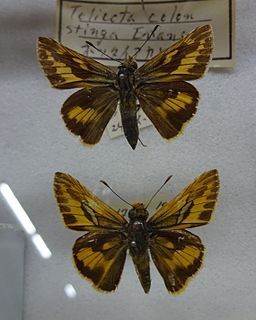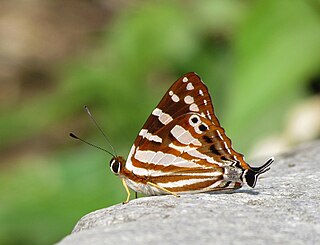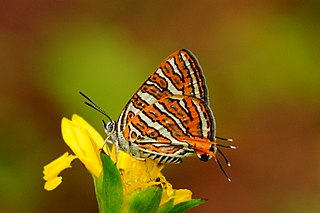Related Research Articles

Telicota colon, commonly known as the pale palm dart or common palm dart, is a butterfly belonging to the family Hesperiidae found in India to Australia.

Dodona egeon, the orange Punch, is a small but striking butterfly found in the Indomalayan realm - in Mussoorie to Assam, Burma (nominate) and Peninsular Malaya that belongs to the family Riodinidae.

Hypolimnas misippus, the Danaid eggfly, mimic, or diadem, is a widespread species of nymphalid butterfly. It is well known for polymorphism and mimicry. Males are blackish with distinctive white spots that are fringed in blue. Females are in multiple forms that include male-like forms while others closely resemble the toxic butterflies Danaus chrysippus and Danaus plexippus. They are found across Africa, Asia, and Australia. In the new world they are found in the West Indies, with strays in Central and North America.

Curetis bulis, the bright sunbeam, is a species of butterfly belonging to the lycaenid family. It is found in Asia.

Cigaritis vulcanus, the common silverline, is a species of lycaenid or blue butterfly found in Asia. It was first described by Johan Christian Fabricius in 1775.
Catalexis is a genus of moths in the family Gelechiidae. It contains the species Catalexis tapinota, which is found in Guatemala.
Cosmopterix etmylaurae is a moth of the family Cosmopterigidae. It is known from Costa Rica.
Cosmopterix gemmiferella is a moth of the family Cosmopterigidae. It is known from the United States and Canada (Ontario).
Cosmopterix lespedezae is a moth of the family Cosmopterigidae. It is known from the United States.
Dichomeris argentaria is a species of moth in the family Gelechiidae. It was described by Edward Meyrick in 1913. It is found in Mpumalanga, South Africa.
Charistica walkeri is a moth in the family Gelechiidae. It was described by Walsingham in 1911. It is found from Panama to Colombia.
Untomia latistriga is a moth of the family Gelechiidae. It was described by Walsingham in 1911. It is found in Mexico (Morelos).

Aristotelia elegantella is a moth of the family Gelechiidae. It was described by Vactor Tousey Chambers in 1874. It is found in North America, where it has been recorded from Arizona, California, Colorado, Illinois, Indiana, Iowa, Kansas, Kentucky, Louisiana, Mississippi, New Mexico, Ohio, Oklahoma, Ontario, Texas and Utah.
Chrysoesthia versicolorella is a moth of the family Gelechiidae. It was described by William D. Kearfott in 1908. It is found in North America, where it has been recorded from California.
Polyhymno colleta is a moth of the family Gelechiidae. It was described by Walsingham in 1911. It is found in Mexico (Guerrero).
Psittacastis pictrix is a moth in the family Depressariidae. It was described by Edward Meyrick in 1921. It is found in Colombia.
Psittacastis incisa is a moth in the family Depressariidae. It was described by Lord Walsingham in 1912. It is found in Mexico (Tabasco) and Panama.
Psittacastis stigmaphylli is a moth in the family Depressariidae. It was described by Lord Walsingham in 1912. It is found on Jamaica.
Eupselia melanostrepta is a moth in the family Depressariidae. It was described by Edward Meyrick in 1880, where it has been recorded from Victoria and Tasmania.
Eupselia theorella is a moth in the family Depressariidae. It was described by Edward Meyrick in 1880. It is found in Australia, where it has been recorded from New South Wales.
References
- ↑ Savela, Markku. "Chrysoesthia Hübner, [1825]". Lepidoptera and Some Other Life Forms. Retrieved November 4, 2017.
- ↑ Moth Photographers Group. Mississippi State University.
- ↑ Proceedings of the Academy of Natural Sciences of Philadelphia 12: 167
- ↑ Stettiner Entomologische Zeitung 39 (7-9): 249
| This article on a moth of the subfamily Apatetrinae is a stub. You can help Wikipedia by expanding it. |